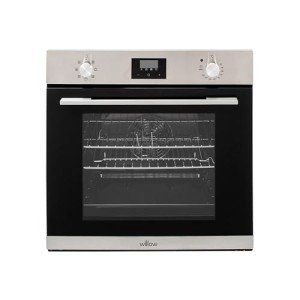10 Basics On Inbuilt Oven You Didn't Learn In School
The Comprehensive Guide to Inbuilt Ovens: Elevating Your Culinary Experience
In the world of modern-day kitchens, the inbuilt oven stands out as a quintessential device that merges functionality with design. Unlike conventional freestanding ovens, inbuilt ovens are developed to integrate seamlessly into cabinetry, offering a smooth look while taking full advantage of offered area. As homes evolve, the demand for efficient and aesthetically pleasing kitchen appliances has actually led to increasing popularity of inbuilt ovens, dealing with the needs of both amateur cooks and cooking experts alike.
What is an Inbuilt Oven?
An inbuilt oven, frequently described as a built-in or integrated oven, is an unit that is developed to be installed within kitchen cabinets. These ovens are available in various shapes, sizes, and technologies, using users a large range of alternatives when it comes to both cooking and kitchen design. They are usually built at eye level, making them quickly accessible without the requirement to flex down, which is a function valued by lots of home cooks.
Types of Inbuilt Ovens
Inbuilt ovens can be classified in numerous methods based on their cooking innovation and style. Here are the main types of inbuilt ovens offered in the market:
Conventional Ovens: These utilize convected heat from leading and bottom components for traditional baking and roasting.
Convection Ovens: Equipped with a fan and exhaust system, stove flow hot air for even cooking, lowering cooking times and enhancing tastes.
Steam Ovens: Using steam to prepare, these ovens keep nutrients and moisture in food, making them perfect for health-conscious individuals.
Mix Ovens: These flexible units can function as both a standard and microwave oven, supplying flexibility for various cooking approaches.
Self-Cleaning Ovens: Featuring automatic cleansing processes, these ovens make upkeep easy and hassle-free, permitting users to focus on cooking.
Benefits of Inbuilt Ovens
Inbuilt ovens provide a myriad of benefits that make them an attractive option for modern-day kitchens. Some of the essential benefits consist of:
Space Efficiency: By fitting into cabinetry, inbuilt ovens save counter area and can permit more kitchen style options.
Ease of access: Elevated styles indicate users can quickly access food without having to flex down.
Aesthetic Appeal: These ovens can be found in a variety of finishes and designs, enabling house owners to develop a cohesive appearance in their kitchen.
Advanced Technology: Many inbuilt ovens come geared up with smart technology functions, such as app control and pre-programmed cooking settings.
Improved Cooking Performance: With alternatives like convection and steam cooking, inbuilt ovens frequently offer superior cooking results.
Function
Traditional Oven
Convection Oven
Steam Oven
Mix Oven
Cooking Method
Convected heat
Fan Assisted
Steam
Multi-Mode
Cooking Time
Basic
Lowered
Basic
Flexible
Maintenance
Moderate
Moderate
Low
Moderate
Nutrient Retention
Low
Moderate
High
High
Rate
Low to Moderate
Moderate
High
High
Factors to consider When Choosing an Inbuilt Oven
Choosing the ideal inbuilt oven for your kitchen involves cautious factor to consider. Here are some factors to believe about:
Size: Measure the area offered in your cabinets to ensure the oven fits completely.
Fuel Type: Decide in between electric and gas ovens based upon your cooking preferences and existing kitchen infrastructure.
Functions: Assess which features are important for your cooking design, such as self-cleaning, wise functions, or specialized cooking modes.
Budget plan: Inbuilt ovens can vary significantly in price. Determine your budget beforehand to limit your choices.
Brand name and Warranty: Research respectable brand names and think about service warranty options as they can reflect the quality and sturdiness of the device.
Popular Brands of Inbuilt Ovens
Here's a fast summary of some popular brands using high-quality inbuilt ovens:
- Bosch: Renowned for innovative technology and efficiency.
- Miele: Known for superior efficiency and trendy styles.
- Electrolux: Offers flexible cooking solutions with innovative features.
- Oven World: Specializes in budget-friendly yet high-performance ovens.
- Smeg: Combines retro design with contemporary functionality.
Often Asked Questions (FAQs)
Q1: Can I set up an inbuilt oven myself?A1: While it is possible for experienced DIYers to install an inbuilt oven, it is usually recommended to have an expert do it to make sure security and proper functioning. Q2: What are the advantages of a steam
oven?A2: Steam ovens are outstanding for maintaining wetness and nutrients in food, making them ideal for healthy cooking. They are ideal for baking bread, steaming veggies, and reheating food without drying it out. Q3: How frequently should I clean my inbuilt oven?A3: It is a good idea to clean your inbuilt oven regularly, especially if utilizing it often. Describe the maker's standards for particular cleansing frequencies and techniques. Q4: Are inbuilt ovens energy-efficient? ovensandhobs : Yes, numerous modern-day inbuilt ovens are designed with energy performance in mind, making use of innovations such as insulation and effective preset cooking programs. Q5: What is the average life expectancy of an
inbuilt oven?A5: With correct care, an inbuilt oven can last in between 10 to 15 years, although maintenance and usage patterns can affect this life-span. An inbuilt oven is more than just a cooking appliance; it is a versatile addition that improves the functionality and aesthetics of any kitchen. With a broad variety of choices available, house owners have the opportunity to choose a model that matches their cooking design and design preferences. As kitchens continue to be the heart of the home, investing in an inbuilt oven might extremely well be one of the very best choices for culinary lovers wanting to raise their cooking experience. Whether opting for innovative functions or welcoming a traditional design, inbuilt ovens undoubtedly supply a path to culinary quality. 